VOLVO XC90 TWIN ENGINE 2019 Owners Manual
Manufacturer: VOLVO, Model Year: 2019, Model line: XC90 TWIN ENGINE, Model: VOLVO XC90 TWIN ENGINE 2019Pages: 697, PDF Size: 10.33 MB
Page 351 of 697

DRIVER SUPPORT
349
City Safety and delayed evasive
maneuvers
City Safety can assist the driver by automatically
braking the vehicle when it is not possible to
avoid a collision by steering alone.
City Safety assists the driver by periodically
attempting to predict possible "escape routes" to
the sides of the vehicle in the event a slow-mov-
ing or stationary vehicle were to be detected at a
late stage.
Your vehicle (1) cannot detect any potential escape
routes for veering away from the vehicle ahead (2) and
may therefore apply the brakes at an earlier stage.
Own vehicle
Slow-moving/stationary vehicles
City Safety will not intervene to automatically
apply the brakes if it is possible for the driver to
avoid a collision by steering the vehicle. However, if City Safety determines that an eva-
sive maneuver would not be possible due to traf-
fic in the adjacent lane(s), the function can assist
the driver by automatically starting to apply the
brakes at an earlier stage.
WARNING
The possibility of City Safety predicting a
certain situation is supplementary driver
support intended to improve driving safety
– it cannot handle all situations in all traf-
fic, weather and road conditions.
City Safety is not a substitute for the driv-
er's attention and judgment. The driver is
always responsible for ensuring the vehi-
cle is driven in a safe manner, at the
appropriate speed, with an appropriate
distance to other vehicles, and in accord-
ance with current traffic rules and regula-
tions.
Limitations of City Safety during evasive
maneuvers
NOTE The function uses the vehicle's combined
camera and radar unit, which has certain gen-
eral limitations; see sections "Camera limita-
tions" and "Radar sensor limitations".
Related information
City Safety™ (p. 341)
Camera limitations (p. 338)
Radar sensor limitations (p. 333)
Page 352 of 697
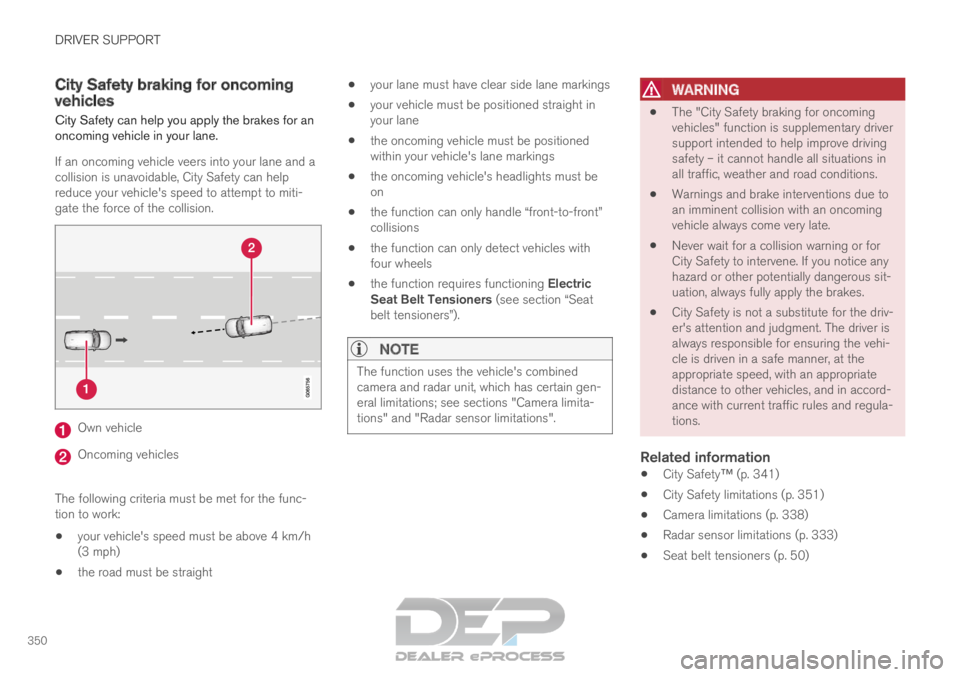
DRIVER SUPPORT
350City Safety braking for oncoming
vehicles
City Safety can help you apply the brakes for an
oncoming vehicle in your lane.
If an oncoming vehicle veers into your lane and a
collision is unavoidable, City Safety can help
reduce your vehicle's speed to attempt to miti-
gate the force of the collision. Own vehicle
Oncoming vehicles
The following criteria must be met for the func-
tion to work:
your vehicle's speed must be above 4 km/h
(3 mph)
the road must be straight
your lane must have clear side lane markings
your vehicle must be positioned straight in
your lane
the oncoming vehicle must be positioned
within your vehicle's lane markings
the oncoming vehicle's headlights must be
on
the function can only handle “front-to-front”
collisions
the function can only detect vehicles with
four wheels
the function requires functioning Electric
Seat Belt Tensioners (see section “Seat
belt tensioners”).
NOTE The function uses the vehicle's combined
camera and radar unit, which has certain gen-
eral limitations; see sections "Camera limita-
tions" and "Radar sensor limitations".
WARNING
The "City Safety braking for oncoming
vehicles" function is supplementary driver
support intended to help improve driving
safety – it cannot handle all situations in
all traffic, weather and road conditions.
Warnings and brake interventions due to
an imminent collision with an oncoming
vehicle always come very late.
Never wait for a collision warning or for
City Safety to intervene. If you notice any
hazard or other potentially dangerous sit-
uation, always fully apply the brakes.
City Safety is not a substitute for the driv-
er's attention and judgment. The driver is
always responsible for ensuring the vehi-
cle is driven in a safe manner, at the
appropriate speed, with an appropriate
distance to other vehicles, and in accord-
ance with current traffic rules and regula-
tions.
Related information
City Safety™ (p. 341)
City Safety limitations (p. 351)
Camera limitations (p. 338)
Radar sensor limitations (p. 333)
Seat belt tensioners (p. 50)
Page 353 of 697
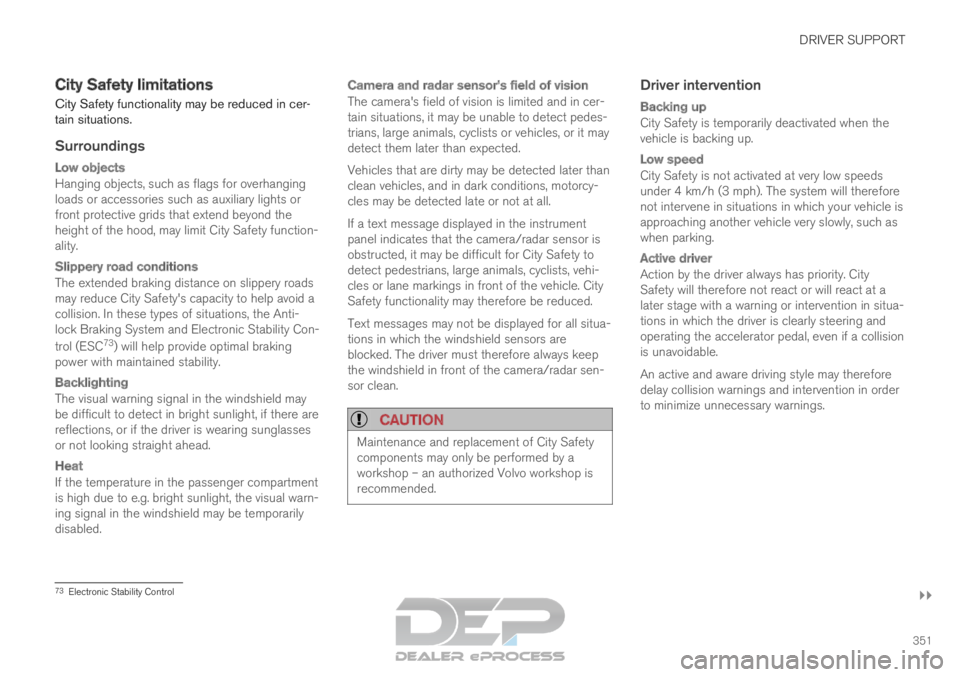
DRIVER SUPPORT
}}
351
City Safety limitations
City Safety functionality may be reduced in cer-
tain situations.
Surroundings
Low objects
Hanging objects, such as flags for overhanging
loads or accessories such as auxiliary lights or
front protective grids that extend beyond the
height of the hood, may limit City Safety function-
ality.
Slippery road conditions
The extended braking distance on slippery roads
may reduce City Safety's capacity to help avoid a
collision. In these types of situations, the Anti-
lock Braking System and Electronic Stability Con-
trol (ESC 73
) will help provide optimal braking
power with maintained stability.
Backlighting
The visual warning signal in the windshield may
be difficult to detect in bright sunlight, if there are
reflections, or if the driver is wearing sunglasses
or not looking straight ahead.
Heat
If the temperature in the passenger compartment
is high due to e.g. bright sunlight, the visual warn-
ing signal in the windshield may be temporarily
disabled.
Camera and radar sensor's field of vision
The camera's field of vision is limited and in cer-
tain situations, it may be unable to detect pedes-
trians, large animals, cyclists or vehicles, or it may
detect them later than expected.
Vehicles that are dirty may be detected later than
clean vehicles, and in dark conditions, motorcy-
cles may be detected late or not at all.
If a text message displayed in the instrument
panel indicates that the camera/radar sensor is
obstructed, it may be difficult for City Safety to
detect pedestrians, large animals, cyclists, vehi-
cles or lane markings in front of the vehicle. City
Safety functionality may therefore be reduced.
Text messages may not be displayed for all situa-
tions in which the windshield sensors are
blocked. The driver must therefore always keep
the windshield in front of the camera/radar sen-
sor clean.
CAUTION Maintenance and replacement of City Safety
components may only be performed by a
workshop – an authorized Volvo workshop is
recommended.
Driver intervention
Backing up
City Safety is temporarily deactivated when the
vehicle is backing up.
Low speed
City Safety is not activated at very low speeds
under 4 km/h (3 mph). The system will therefore
not intervene in situations in which your vehicle is
approaching another vehicle very slowly, such as
when parking.
Active driver
Action by the driver always has priority. City
Safety will therefore not react or will react at a
later stage with a warning or intervention in situa-
tions in which the driver is clearly steering and
operating the accelerator pedal, even if a collision
is unavoidable.
An active and aware driving style may therefore
delay collision warnings and intervention in order
to minimize unnecessary warnings.
73
Electronic Stability Control
Page 354 of 697
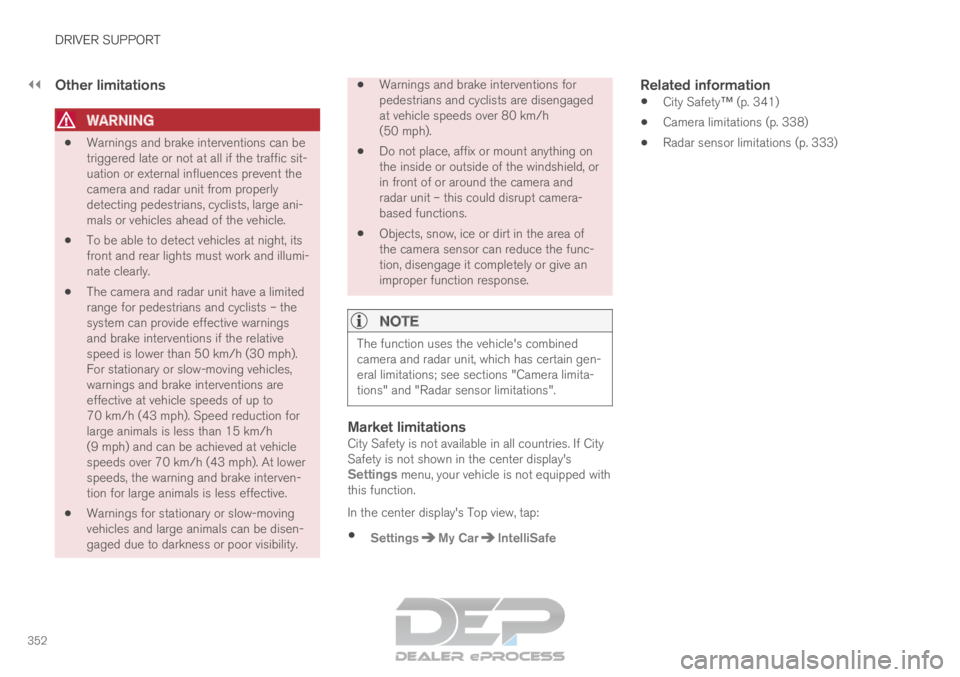
||DRIVER SUPPORT
352
Other limitations
WARNING
Warnings and brake interventions can be
triggered late or not at all if the traffic sit-
uation or external influences prevent the
camera and radar unit from properly
detecting pedestrians, cyclists, large ani-
mals or vehicles ahead of the vehicle.
To be able to detect vehicles at night, its
front and rear lights must work and illumi-
nate clearly.
The camera and radar unit have a limited
range for pedestrians and cyclists – the
system can provide effective warnings
and brake interventions if the relative
speed is lower than 50 km/h (30 mph).
For stationary or slow-moving vehicles,
warnings and brake interventions are
effective at vehicle speeds of up to
70 km/h (43 mph). Speed reduction for
large animals is less than 15 km/h
(9 mph) and can be achieved at vehicle
speeds over 70 km/h (43 mph). At lower
speeds, the warning and brake interven-
tion for large animals is less effective.
Warnings for stationary or slow-moving
vehicles and large animals can be disen-
gaged due to darkness or poor visibility.
Warnings and brake interventions for
pedestrians and cyclists are disengaged
at vehicle speeds over 80 km/h
(50 mph).
Do not place, affix or mount anything on
the inside or outside of the windshield, or
in front of or around the camera and
radar unit – this could disrupt camera-
based functions.
Objects, snow, ice or dirt in the area of
the camera sensor can reduce the func-
tion, disengage it completely or give an
improper function response.
NOTE The function uses the vehicle's combined
camera and radar unit, which has certain gen-
eral limitations; see sections "Camera limita-
tions" and "Radar sensor limitations".
Market limitationsCity Safety is not available in all countries. If City
Safety is not shown in the center display's
Settings menu, your vehicle is not equipped with
this function.
In the center display's Top view, tap:
Settings My Car IntelliSafe
Related information
City Safety™ (p. 341)
Camera limitations (p. 338)
Radar sensor limitations (p. 333)
Page 355 of 697

DRIVER SUPPORT
353
City Safety messages
A number of messages related to City Safety
may be displayed in the instrument panel.
Some examples of symbols and messages are shown in the table below.
Message
Meaning
City Safety
Automatic intervention When City Safety is braking or has activated the automatic braking funct\
ion, one or more symbols may illuminate in
the instrument panel and a text message may be displayed.
City Safety
Reduced functionality Service
required The system is not functioning as intended. Contact a workshop ‒ an authorized Volvo workshop is recommended.A text message can be erased by briefly pressing
the
button in the center of the right-side
steering wheel keypad.
If the message persists: Contact a workshop ‒ an
authorized Volvo workshop is recommended.
Related information
City Safety™ (p. 341)
Page 356 of 697
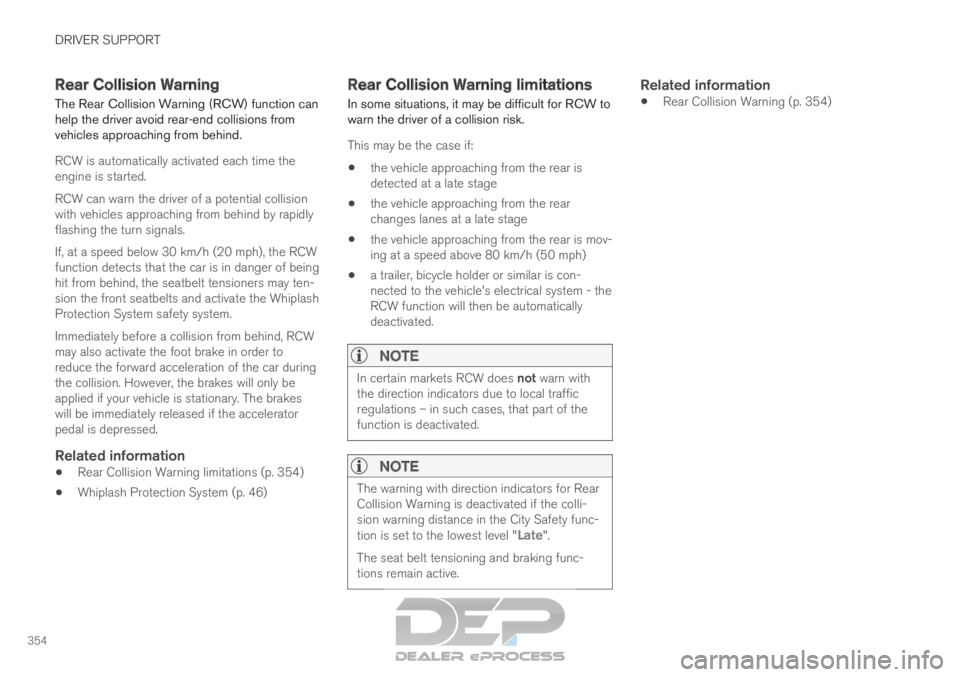
DRIVER SUPPORT
354Rear Collision Warning
The Rear Collision Warning (
RCW) function can
help the driver avoid rear-end collisions from
vehicles approaching from behind.
RCW is automatically activated each time the
engine is started.
RCW can warn the driver of a potential collision
with vehicles approaching from behind by rapidly
flashing the turn signals.
If, at a speed below 30 km/h (20 mph), the RCW
function detects that the car is in danger of being
hit from behind, the seatbelt tensioners may ten-
sion the front seatbelts and activate the Whiplash
Protection System safety system.
Immediately before a collision from behind, RCW
may also activate the foot brake in order to
reduce the forward acceleration of the car during
the collision. However, the brakes will only be
applied if your vehicle is stationary. The brakes
will be immediately released if the accelerator
pedal is depressed.
Related information
Rear Collision Warning limitations (p. 354)
Whiplash Protection System (p. 46) Rear Collision Warning limitations
In some situations, it may be difficult for RCW to
warn the driver of a collision risk.
This may be the case if: the vehicle approaching from the rear is
detected at a late stage
the vehicle approaching from the rear
changes lanes at a late stage
the vehicle approaching from the rear is mov-
ing at a speed above 80 km/h (50 mph)
a trailer, bicycle holder or similar is con-
nected to the vehicle's electrical system - the
RCW function will then be automatically
deactivated.
NOTE In certain markets RCW does not warn with
the direction indicators due to local traffic
regulations – in such cases, that part of the
function is deactivated.
NOTE The warning with direction indicators for Rear
Collision Warning is deactivated if the colli-
sion warning distance in the City Safety func-
tion is set to the lowest level "
Late".
The seat belt tensioning and braking func-
tions remain active.
Related information
Rear Collision Warning (p. 354)
Page 357 of 697

DRIVER SUPPORT
}}
* Option/accessory. 355
BLIS*
The BLIS 74
function is designed to help provide
assistance in heavy traffic with several lanes
moving in the same direction by helping the
driver to detect the presence of vehicles in the
"blind spot" area behind and to the side of the
vehicle.
BLIS is a driver support system designed to alert
the driver of:
vehicles in your "blind spot"
vehicles approaching rapidly in adjacent
lanes. Location of BLIS indicator light.
75 Indicator light
The BLIS button in the center display's Func-
tion view is used to activate/deactivate the
function. BLIS overview
Blind spot zone
Rapidly approaching vehicle zone.
The BLIS function is active at speeds
above 10 km/h (6 mph).
The system is designed to react to: vehicles passing your vehicle
vehicles that are rapidly approaching your
vehicle from behind.
When BLIS
detects a vehicle in zone 1 or a rap-
idly approaching vehicle in zone 2, an indicator
light will illuminate in the relevant rearview mirror
and glow steadily. If the driver then uses the turn
signal on the side in which the warning has been 74
Blind Spot Information Systems
75 Note: This illustration is general and details may vary depending on mod\
el.
Page 358 of 697
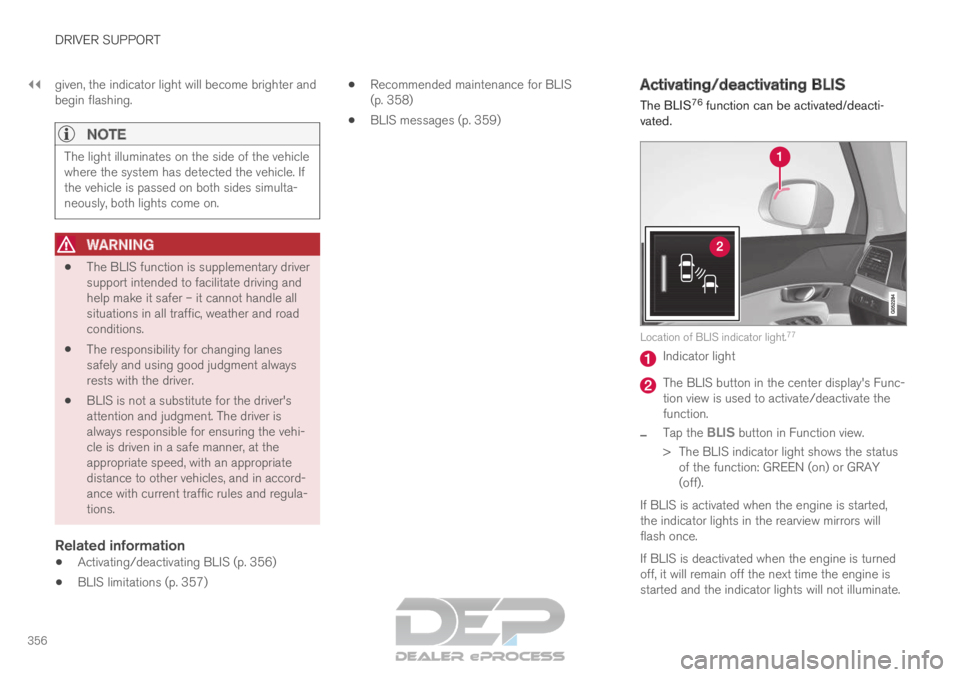
||DRIVER SUPPORT
356
given, the indicator light will become brighter and
begin flashing.
NOTE
The light illuminates on the side of the vehicle
where the system has detected the vehicle. If
the vehicle is passed on both sides simulta-
neously, both lights come on.
WARNING
The BLIS function is supplementary driver
support intended to facilitate driving and
help make it safer – it cannot handle all
situations in all traffic, weather and road
conditions.
The responsibility for changing lanes
safely and using good judgment always
rests with the driver.
BLIS is not a substitute for the driver's
attention and judgment. The driver is
always responsible for ensuring the vehi-
cle is driven in a safe manner, at the
appropriate speed, with an appropriate
distance to other vehicles, and in accord-
ance with current traffic rules and regula-
tions.
Related information
Activating/deactivating BLIS (p. 356)
BLIS limitations (p. 357)
Recommended maintenance for BLIS
(p. 358)
BLIS messages (p. 359) Activating/deactivating BLIS
The BLIS
76
function can be activated/deacti-
vated. Location of BLIS indicator light.
77 Indicator light
The BLIS button in the center display's Func-
tion view is used to activate/deactivate the
function.
– Tap the
BLIS button in Function view.
>
The BLIS indicator light shows the status
of the function: GREEN (on) or GRAY
(off).
If BLIS is activated when the engine is started,
the indicator lights in the rearview mirrors will
flash once.
If BLIS is deactivated when the engine is turned
off, it will remain off the next time the engine is
started and the indicator lights will not illuminate.
Page 359 of 697
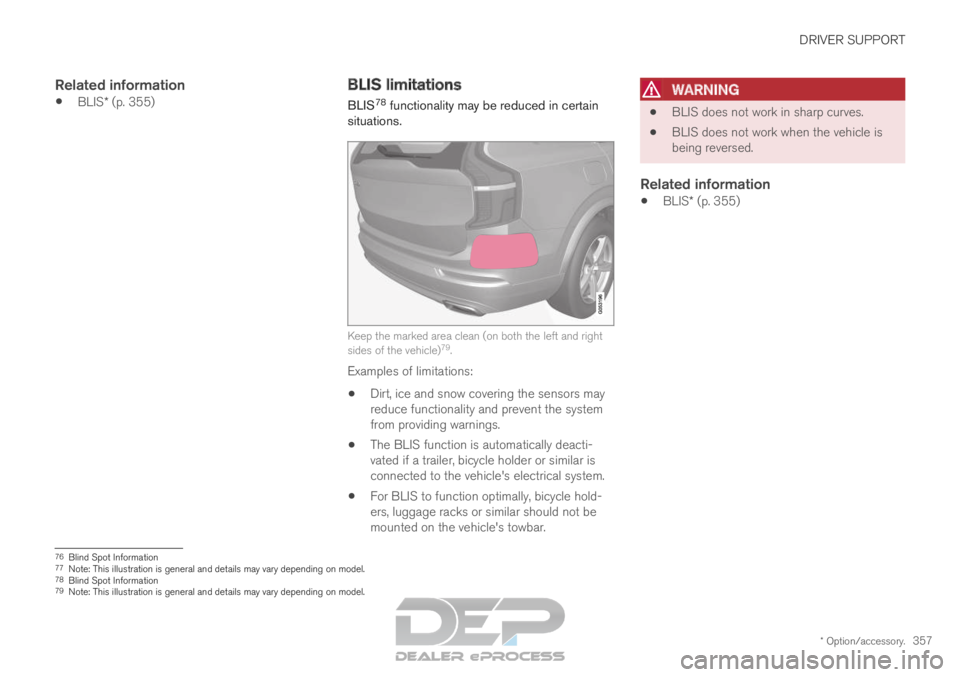
DRIVER SUPPORT
* Option/accessory.357
Related information
BLIS* (p. 355) BLIS limitations
BLIS 78
functionality may be reduced in certain
situations. Keep the marked area clean (on both the left and right
sides of the vehicle)
79
.
Examples of limitations:
Dirt, ice and snow covering the sensors may
reduce functionality and prevent the system
from providing warnings.
The BLIS function is automatically deacti-
vated if a trailer, bicycle holder or similar is
connected to the vehicle's electrical system.
For BLIS to function optimally, bicycle hold-
ers, luggage racks or similar should not be
mounted on the vehicle's towbar.WARNING
BLIS does not work in sharp curves.
BLIS does not work when the vehicle is
being reversed.
Related information
BLIS* (p. 355) 76
Blind Spot Information
77 Note: This illustration is general and details may vary depending on mod\
el.
78 Blind Spot Information
79 Note: This illustration is general and details may vary depending on mod\
el.
Page 360 of 697
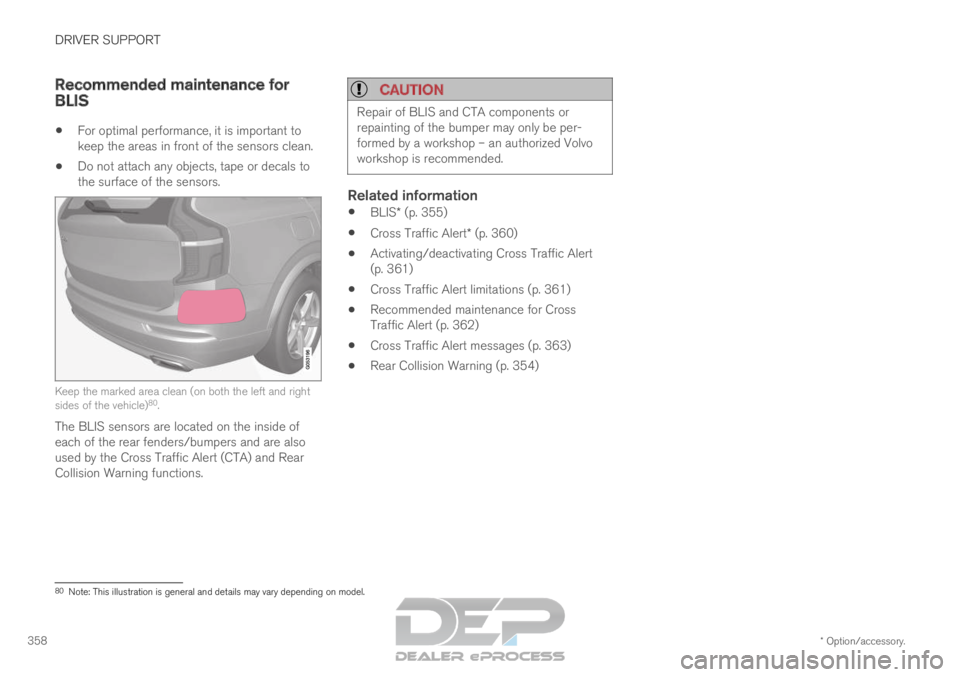
DRIVER SUPPORT
* Option/accessory.
358 Recommended maintenance for
BLIS
For optimal performance, it is important to
keep the areas in front of the sensors clean.
Do not attach any objects, tape or decals to
the surface of the sensors. Keep the marked area clean (on both the left and right
sides of the vehicle)
80
.
The BLIS sensors are located on the inside of
each of the rear fenders/bumpers and are also
used by the Cross Traffic Alert (CTA) and Rear
Collision Warning functions.
CAUTION Repair of BLIS and CTA components or
repainting of the bumper may only be per-
formed by a workshop – an authorized Volvo
workshop is recommended.
Related information
BLIS* (p. 355)
Cross Traffic Alert* (p. 360)
Activating/deactivating Cross Traffic Alert
(p. 361)
Cross Traffic Alert limitations (p. 361)
Recommended maintenance for Cross
Traffic Alert (p. 362)
Cross Traffic Alert messages (p. 363)
Rear Collision Warning (p. 354) 80
Note: This illustration is general and details may vary depending on mod\
el.